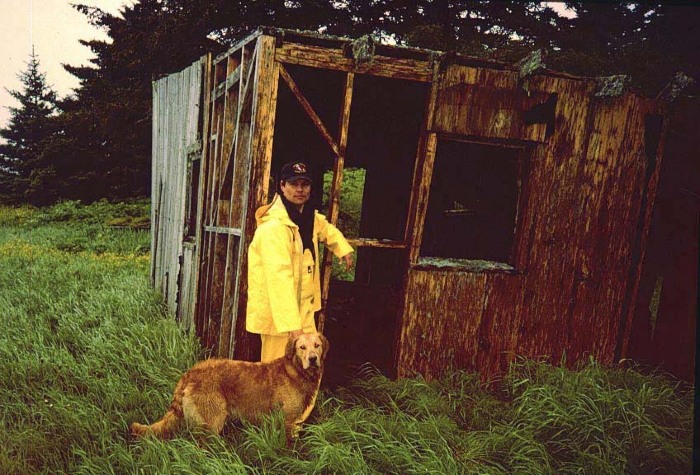Pet — Qungutuwaq
Qungutuwangq'rtua. – I have a pet.

Photo: Rick Rowland and his dog Shaman, Afognak Village, 1997, AM628
Qungutuwaq is the Alutiiq word for a tame animal. It likely began as a term for a wild animal habituated to people, but it has come to mean all kinds of pets. Tame animals, especially birds and dogs, were part of ancestral Alutiiq villages. Alutiiq people kept both eagles and crows. In 1805, Russian trader Uri Lisianski observed an eagle fly into a sod house and sit by the fire. Family members told Lisianski that the bird recognized them. When their kayaks returned from a day of fishing, the bird would fly back to the house to join them.
Dog bones are widely present in ancestral villages sites and suggest that domestic dogs (Canis lupus familiaris) were a part of Alutiiq communities for at least a thousand years. Although Alutiiq people made and used sleds for hauling firewood, there is no evidence of dog traction. It is more likely that dogs provided protection from bears and were hunting companions. Historic accounts mention dogs being dogs—roaming villages, eating garbage, chewing on skin boats, and sleeping in sod houses with families. During the Russian era, hunters used dogs to harvest ground squirrels on Chirikof Island. Up to 200 dogs were used to sniff out squirrel dens. Once located, a hunter would quickly dig out the animal and dispatch it. Hunts like these could yield over a thousand pelts.
In the 20th century the diversity of pets and domestic animals in Alutiiq villages grew. A survey of Alutiiq households in 1985, revealed that dogs remained popular pets, but many other animals were kept for companionship and food. For example, the 178 residents of Larsen Bay had 59 dogs, 52 cats, 71 pet fish, 5 birds, 92 chickens, 7 goats, 1 pony, 5 ducks, and 4 geese. In other villages people also kept pet rabbits, turtles, and frogs.
Dog bones are widely present in ancestral villages sites and suggest that domestic dogs (Canis lupus familiaris) were a part of Alutiiq communities for at least a thousand years. Although Alutiiq people made and used sleds for hauling firewood, there is no evidence of dog traction. It is more likely that dogs provided protection from bears and were hunting companions. Historic accounts mention dogs being dogs—roaming villages, eating garbage, chewing on skin boats, and sleeping in sod houses with families. During the Russian era, hunters used dogs to harvest ground squirrels on Chirikof Island. Up to 200 dogs were used to sniff out squirrel dens. Once located, a hunter would quickly dig out the animal and dispatch it. Hunts like these could yield over a thousand pelts.
In the 20th century the diversity of pets and domestic animals in Alutiiq villages grew. A survey of Alutiiq households in 1985, revealed that dogs remained popular pets, but many other animals were kept for companionship and food. For example, the 178 residents of Larsen Bay had 59 dogs, 52 cats, 71 pet fish, 5 birds, 92 chickens, 7 goats, 1 pony, 5 ducks, and 4 geese. In other villages people also kept pet rabbits, turtles, and frogs.
